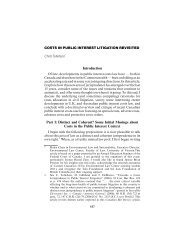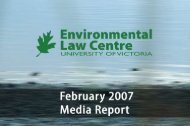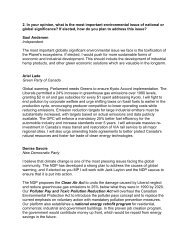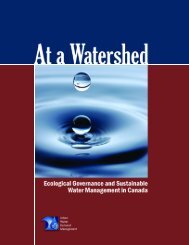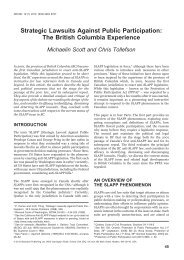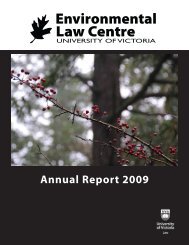Peeling back the Pavement - POLIS Water Sustainability Project
Peeling back the Pavement - POLIS Water Sustainability Project
Peeling back the Pavement - POLIS Water Sustainability Project
You also want an ePaper? Increase the reach of your titles
YUMPU automatically turns print PDFs into web optimized ePapers that Google loves.
water supplies, and flooding all result in negative impacts on fish populations and<br />
habitat. In this way, a distant land-use decision triggers a range of impacts on local<br />
water resources and ecosystems.<br />
Many studies and experts point to <strong>the</strong> need to plan human activities across entire<br />
watersheds to fully assess land-use decisions for ecosystem impacts. 43 This rationale<br />
is based on recognition of <strong>the</strong> water cycle as <strong>the</strong> pathway that integrates <strong>the</strong><br />
physical, chemical, and biological processes of <strong>the</strong> entire regional ecosystem. For<br />
example, when an upstream city has a significant amount of impermeable surfaces,<br />
a large quantity of polluted runoff is generated which directly affects downstream<br />
communities and ecosystems. The Rainwater City recognizes <strong>the</strong> importance of<br />
scale when considering <strong>the</strong> relationship between land use and ecosystem impacts.<br />
As a result, a watershed governance approach is adopted to address <strong>the</strong> complex<br />
and interdependent dynamics of water, land, and human and wildlife needs and<br />
activities across a landscape.<br />
An appropriate vehicle for integrating ecosystem-based land management into <strong>the</strong><br />
Rainwater City is an integrated water management plan that recognizes all water—<br />
including rainwater—is connected. Such a plan uses <strong>the</strong> watershed as <strong>the</strong> primary<br />
boundary for all land-use planning. It enables a bird’s-eye-view understanding of<br />
ecosystem function and status within an entire drainage area and accounts for<br />
ecological considerations that need to be integrated into land-use planning and<br />
decision making. With an integrated water management plan, local governments<br />
in a Rainwater City are enabled to develop and implement a rainwater plan for <strong>the</strong><br />
entire urban watershed or basin through changes to provincial or territorial legislation<br />
via Local Government Acts and Municipal Acts. 44<br />
Plans that focus on rainwater management across a region are rare in Canada.<br />
However, <strong>the</strong>re are exceptions. The City of Toronto’s Wet Wea<strong>the</strong>r Flow Management<br />
Master Plan (approved in 2003) is a watershed-based stormwater plan that<br />
treats <strong>the</strong> area’s natural landscape as a whole functioning system. The Toronto and<br />
Region Conservation Authority (TRCA) is an important example of a watershed<br />
governance body that is actively ensuring a “think like a watershed” approach in<br />
<strong>the</strong> city. Working with <strong>the</strong> City, TRCA liaises with neighbouring municipalities to develop<br />
consistent stormwater criteria for new development and protective measures<br />
where development already exists. Metro Vancouver’s Integrated Liquid Waste<br />
and Resource Management Plan is a leading document that uses an ecosystembased<br />
approach to managing stormwater on a regional scale. Although its focus is<br />
replacing <strong>the</strong> 50-year-old Lions Gate and Iona Island primary sewage plants with<br />
advanced treatment facilities, <strong>the</strong> plan is also built around <strong>the</strong> goal of improving<br />
<strong>the</strong> natural environment in <strong>the</strong> region. The plan ultimately integrates liquid and<br />
solid waste recovery, rainwater management, and land-use planning for <strong>the</strong> entire<br />
Greater Vancouver area.<br />
47



